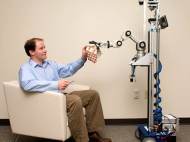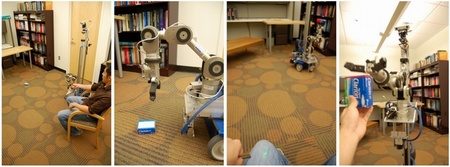Robot El-E assists to people with motor impairments
 Most of us take our interaction with the world around us for granted. Manipulating objects play an especially important role in people’s lives. El-E is an assistive robot that is explicitly designed to take advantage of this common structure in order to retrieve unmodeled, everyday objects for people with motor impairments. Georgia Tech’s Healthcare Robotics Lab published an update related to the robots abilities.
Most of us take our interaction with the world around us for granted. Manipulating objects play an especially important role in people’s lives. El-E is an assistive robot that is explicitly designed to take advantage of this common structure in order to retrieve unmodeled, everyday objects for people with motor impairments. Georgia Tech’s Healthcare Robotics Lab published an update related to the robots abilities.
El-E is about 1.5 meters tall, with a single robotic arm that can move up and down to pick up objects at different heights. The robot moves with a motorized, wheeled base. It is powered by a Mac Mini with the Ubuntu Linux operating system.
It is equipped with a laser pointer interface that detects when its owner illuminates a location with an off-the-shelf green laser pointer and estimates its 3D position. This enables a user to explicitly point a 3D location to the robot using a “point-and-click” style of interaction, which provides a direct way to tell the robot which object to manipulate or where to go.
Furthermore, the robot is able translate its manipulator and associated sensors to different heights, which enables it to grasp objects on a variety of surfaces, such as the floor and tables, using the same perception and manipulation strategies. The robot can approach a selected object which was pointed with the usage of the laser pointer interface, detect if the object is on an elevated surface, thus adapting the position of its sensors and arm in order to grasp the object both tactile and visually. Once the object is acquired, the robot can place the object on a laser designated surface above the floor, follow the laser pointer on the floor, or deliver the object to a seated person selected with the laser pointer.
After successful early trials, the lab expanded El-E’s interface and implemented support to combine voice commands with the laser in order to accomplish more complex tasks, like opening doors. The robot recognizes words such as “tug” or “push” and performs the action on an object illuminated by the laser. But the robot still has some training ahead before it can work outside the lab.
In order to add more functionality project director Prof. Charlie Kemp and his colleagues are focusing on programming El-E to locate and fetch common household items such as a hairbrush, a bottle of pills, a cell phone or a TV remote.
El-E could provide more independence for the patients with motor impairments and a respite for caregivers. Kemp said he hopes his robots could help people in wheelchairs, the elderly and those with such diseases as arthritis and diabetes.
“There is still significant research to be done in order to make robots like El-E function in real homes on a daily basis,” Kemp said. “Real homes contain a diverse array of objects, have obstacles that make robot navigation difficult, have varied lighting, contain fragile items, provide shelter to pets and family members, and have messy areas.”
The robot is designed to learn from its mistakes. “In this case, it missed the object. It should try again actually, and it should recognize that it didn’t succeed,” Kemp said. Formal studies have shown El-E to be an efficient worker. In 127 out of 134 trials (94.8 percent), the robot successfully picked up the requested object.
When El-E is ready to work, it says: “Waiting for laser command.” After the patient points at an object, the robot acknowledges, with the words, “Detected laser pointer.” Patients can decide whether El-E should put the object on a table or put it directly in their hands.










Leave your response!